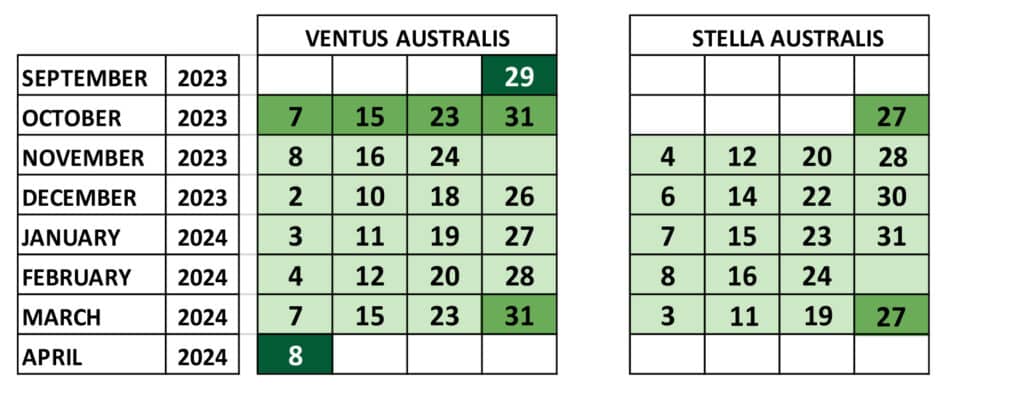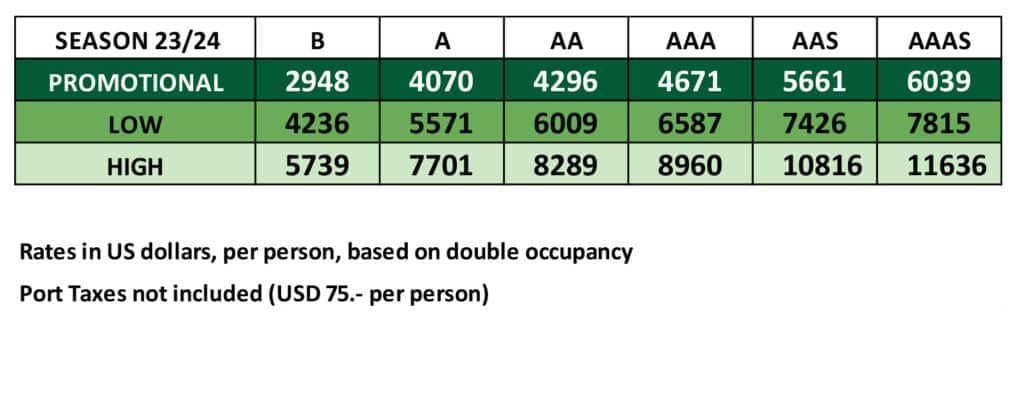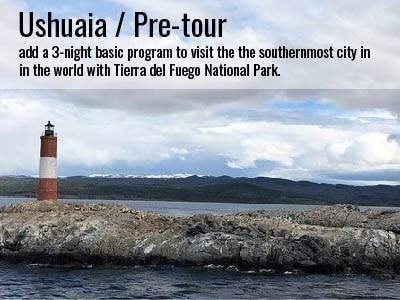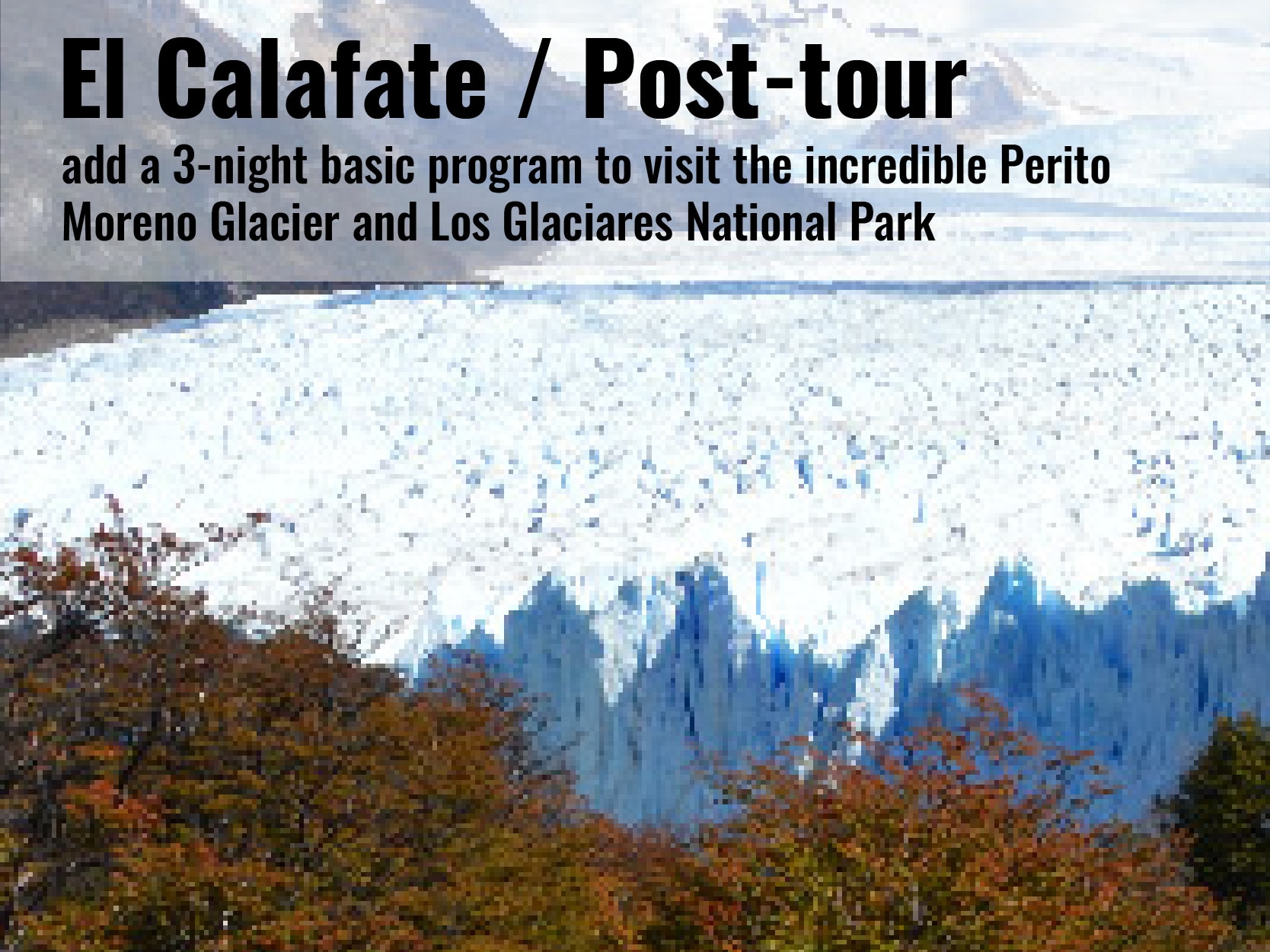
Best Season | Shoulder Season | Low Season | Not Available
Departing from Ushuaia, retrace the route of Charles Darwin aboard HMS Beagle on an expedition cruise through the secluded Fuegian Archipelago at the bottom of South America. It`s an amazing expedition cruise to enjoy the best of the southern channels, fjords and glaciers in Patagonia, and the incredible and famous Cape Horn!
Our adventurous nine-day (eight-night) itinerary includes legendary Cape Horn and historic Wulaia Bay, as well as Glacier Alley, the penguin boisterous colonies on Tuckers and Magdalena islands, as well as the spectacular fjords that harbor Pía and Águila glaciers. While visiting Patagonia you’ll also encounter massive ice fields, lush sub-polar forests and secluded beaches on islands that remain refreshingly remote and barely touched by civilization, a rare glimpse of what planet Earth must have been like before mankind. Midway through the journey, a half-day port call in Punta Arenas leaves plenty of time to explore a city rich in history, architecture and Patagonian culture before resuming the journey back to Ushuaia.
Are you ready to enjoy our 8-night Australis Cruise?
Check in at 409 San Martín Ave., downtown Ushuaia, between 10:00 and 17:00 (10 AM – 5 PM) on the day of your cruise departure.
Board the Australis Cruise at 18:00 (6 PM). After a welcoming toast and introduction of the captain and crew, the ship will set sail for one of the most remote corners of the Earth. During the night, we will traverse the Beagle Channel and cross from Argentina into Chilean territorial waters. The lights of Ushuaia will fade as we navigate the narrow Murray Channel between Navarino and Hoste islands.

At dawn, the Australis cruise will cross Nassau Bay and enter the remote archipelago of Cape Horn National Park. Weather and sea conditions permitting, we will go ashore on the windswept island that hosts the legendary Cape Horn (Cabo de Hornos). Discovered in 1616 by a Dutch maritime expedition and named after the town of Hoorn in West Friesland, Cape Horn is a sheer 425-meter (1,394-foot) high promontory overlooking the turbulent Drake Passage. It was once the only navigation route between the Pacific and Atlantic and was often called the “End of the Earth.” The park was declared a World Biosphere Reserve by UNESCO in 2005. The Chilean navy maintains a lighthouse on the island, staffed by a lightkeeper and his family, and there is also a small chapel and a modern Cape Horn Monument (currently awaiting repair).
After returning across Nassau Bay, we will anchor at the historic Wulaia Bay. Once the site of one of the largest Yámana aboriginal settlements, this bay was described by Charles Darwin and sketched by Captain FitzRoy during their 1830s voyages on HMS Beagle. The area is renowned for its dramatic beauty and geography. After visiting the Australis-sponsored museum in the old radio station, which focuses on the Yámana people and European missionaries, you can choose from three hikes (of increasing difficulty) that ascend the wooded mountain behind the bay. These hikes offer enchanting views of the Magellanic forest and panoramic viewpoints overlooking the bay.
Overnight, we will sail around the western end of Tierra del Fuego via the narrow Gabrial, Magdalena, and Cockburn Channels. After rounding the remote Brecknock Peninsula, we will head eastward and re-enter the Beagle Channel. In the morning, we will enter Pia Fjord and board Zodiacs for a shore excursion to Pia Glacier. After disembarking, you can take a short hike for a panoramic view of the glacier or a longer, more challenging walk up a lateral moraine of the old Pia Glacier. The glacier’s feminine name is a mystery, but one theory suggests it was named after Princess Maria Pia of Savoy (1847-1911), daughter of the Italian king.
Continuing west along the Beagle Channel, we will anchor near Garibaldi Glacier for another shore excursion. Garibaldi is one of only three glaciers in Patagonia that is gaining mass rather than shrinking. We will hike through virgin Magellanic forest to a glacial waterfall, a towering wall of ferns and moss, and breathtaking viewpoints of the glacier and fjord. This hike is demanding — very steep with rough footing — and not for everyone. Those who prefer can stay onboard and enjoy the panoramic view of the beautiful Garibaldi Glacier from the upper decks.

Early in the morning, we will sail through the Cockburn Channel and enter Agostini Sound. Here, you can see glaciers descending from the Darwin Mountain Range, some reaching the water. We will disembark for an easy walk around a lagoon formed by the melting Águila Glacier, reaching a spot with stunning views of the glacier. In the afternoon, we will approach Condor Glacier via Zodiac and, hopefully, spot some of the abundant Andean Condors in the area.
After an overnight cruise through the Magdalena Channel and back into the Strait of Magellan, we will anchor off Magdalena Island, located about halfway between Tierra del Fuego and the Chilean mainland. Crowned by a distinctive lighthouse, the island was once a vital supply stop for navigators and explorers and is now home to a vast colony of Magellanic penguins. Weather permitting, we will go ashore at dawn and hike a path through thousands of penguins to a small museum inside the vintage 1902 lighthouse. In September and April, when the penguins are elsewhere, this excursion will be replaced by a Zodiac ride to Marta Island to observe South American sea lions. After a brief cruise south along the strait, disembarkation at Punta Arenas is scheduled around 11:30 AM. Feel free to explore the city until you reboard the vessel at 18:00 (6 PM). After a welcoming toast and introduction of the captain and crew, the ship will depart on the second leg of the journey. During the night, the lights of Punta Arenas will fade as we cross the Strait of Magellan and enter the Whiteside Canal between Darwin Island and Isla Grande de Tierra del Fuego. Note: Camera extension poles are prohibited on Magdalena Island.

By dawn, we will be sailing up Admiralty Sound between the snow-capped peaks of Karukinka and the fjords of Alberto de Agostini National Park. We will go ashore at Ainsworth Bay, known for its abundant birdlife and elephant seals. Two guided hikes are available, both offering excellent views of Marinelli Glacier and the Darwin Mountains. After leaving Ainsworth Bay, we will sail west to the Tuckers Islets for a close-up encounter with 4,000 Magellanic penguins nesting there. Other bird species are also frequent visitors. In September and April, when the penguins are elsewhere, this excursion will be replaced by a beach walk to a glacier at Brookes Bay.
Overnight, we will sail around the western end of Tierra del Fuego via the Gabrial, Magdalena, and Cockburn Channels. After rounding the Brecknock Peninsula, we will head east and re-enter the Beagle Channel. By morning, we will be entering Pia Fjord again and boarding Zodiacs for a shore excursion to Pia Glacier. You can take a short hike for a panoramic view of the glacier or a longer, more challenging walk up a lateral moraine of the old Pia Glacier. The glacier’s feminine name is mysterious, but one theory is that it was named after Princess Maria Pia of Savoy (1847-1911), daughter of the Italian king.
Back onboard, we will continue east along the Beagle Channel through Glacier Alley. True to its name, this passage features several impressive tidewater glaciers flowing down from the Darwin Mountains and Darwin Ice Sheet on the north shore, many named after European countries – Holland, Italy, Germany, Spain, and France.
Early in the morning, we will navigate the narrow Murray Channel between Navarino and Hoste islands and drop anchor at historic Wulaia Bay. This bay, once the site of one of the region’s largest Yámana aboriginal settlements, was described by Charles Darwin and sketched by Captain FitzRoy during their voyages on HMS Beagle in the 1830s. The area is renowned for its beauty and dramatic geography. After visiting the Australis-sponsored museum in the old radio station, focusing on the Yámana people and European missionaries, you can choose from three hikes (of increasing difficulty) ascending the wooded mountain behind the bay. These hikes offer enchanting views of the Magellanic forest and panoramic viewpoints overlooking the bay. Before leaving Wulaia Bay, drop a letter or postcard into the wooden mail barrel in the museum – an ancient mariner tradition revived by Australis.
In the afternoon, we will cruise across Nassau Bay into the remote archipelago of Cape Horn National Park. Weather and sea conditions permitting, we will go ashore on the windswept island that hosts the legendary Cape Horn (Cabo de Hornos). Discovered in 1616 by a Dutch maritime expedition and named after the town of Hoorn in West Friesland, Cape Horn is a sheer 425-meter (1,394-foot) high promontory overlooking the Drake Passage. It was once the only navigation route between the Pacific and Atlantic and was known as the “End of the Earth.” The park was declared a World Biosphere Reserve by UNESCO in 2005. The Chilean navy maintains a lighthouse on the island, staffed by a lightkeeper and his family, and there is also a small chapel and a modern Cape Horn Monument.

In the morning, we will sail into Argentine waters and dock in Ushuaia, the world’s southernmost city. Arrival is scheduled between 08:30 and 09:30, depending on the departure date.





USHUAIA EXTENSION PROGRAM!
Ushuaia is the southernmost city in the world. Add this extension and enjoy a 3-night package to visit Tierra del Fuego National Park, the Train of the End of the World, navigate the Beagle Channel, visit the mythical Museo del Presidio, see penguins, visit Fagnano and Escondido Lakes, and much more:
DAY 1 – Arrival to Ushuaia
DAY 2 – Visit to Tierra del Fuego National Park + Train of the End of the World + Beagle Channel Navigation.
DAY 3 – Choose from visit to Fagnano and Escondido, 4×4 ride in Tierra del Fuego Island, Trekking to Laguna Esmeralda and more
DAY 4 – Transfer out. Good bye Ushuaia

EL CALAFATE EXTENSION!
Enjoy El Calafate, gate to the incredible Perito Moreno and many glaciers in Los Glaciares National Park. This area is one of the highlights in Patagonia and Argentina.
DAY 1 – Welcome to El Calafate. Free time
DAY 2 – Visit to the incredible Perito Moreno Glacier. You can add a minitrekking to walk over the ice of the glacier
DAY 3 – Choose from some good options to navigate the Argentino Lake in Los Glaciares National Park and enjoy different glaciers!
DAY 4 – Good bye El Calafate!








